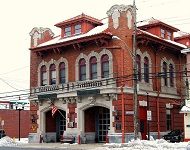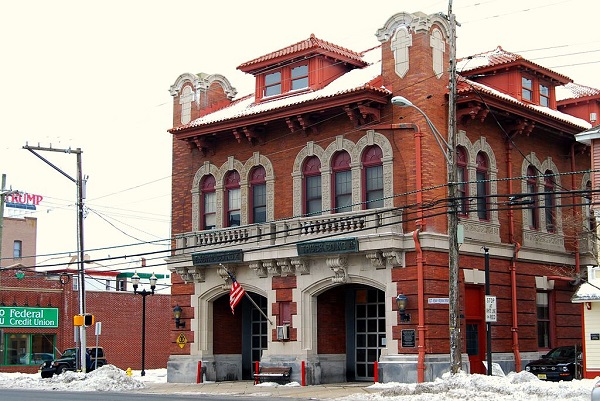
The Fire Officer’s Guide to the Tough Community Questions, Part 5

Firehouse for the Atlantic City (NJ) Fire Department. (Photo by Paul Lowry.)
By Mark Wallace
Elected officials, key stakeholders, and/or the media often ask tough questions regarding proposals or operational practices that put fire officials on the defensive. They expect us to have a logical and compelling explanation to all of their questions and at a moment’s notice. Therefore, it is helpful to consider answers to their questions in advance.
For Part 5 of this series, let’s look at some answers to the following question.
When and Why Do We Need to Build Another Fire Station?
This question will likely be asked after a proposal by the chief to either replace an old, outdated-inadequate fire station, when the jurisdiction has (or is) growing in population and overall area, or after a controversy that involved what is considered an excessive response time to an emergency.
Fire stations have been built to meet a community’s needs at the time of the community’s inception. Historically, as communities grew, the department transitioned from an all-volunteer force (members did not “live” at the station) to a career department with 24-hour shifts requiring kitchen and sleeping accommodations. Also, as building infrastructures fail and reach the end of their useful service life, they require constant maintenance and repair. Current safety standards are difficult, if not impossible, to meet in old historic stations that are now 50 or more years old. And yes, fire apparatus has gotten larger.
Departments that maintain its historical apparatus can see that the overall size of fire apparatus has changed over time; just compare your oldest engine to your newest one. National Fire Protection Standards (NFPA) standards have changed many times over the years, and each change added additional safety design features and equipment. There’s always a story out there about a new fire truck that was delivered only to find out that it was either too long or too tall to fit into the existing fire station. (Of course, that did not happen in your department, but most of us can probably relate.)
Many times, the area protected by a specific fire station has changed over time and now requires more than just a single engine company. Many stations today have multiple companies operating out of a single station or they have a need to operate this way such as with an engine company, a truck company, an ambulance/medical response unit, a heavy rescue, and a battalion chief. Often, newer stations provide space for reserve equipment and other rolling stock.
Effective preplanning and facility design is key to providing the right resources for the fire station throughout its useful lifespan. When this has not happened effectively, the really tough question is, Why not? And, what do you propose to do about the situation?
The fabrics used for bunker (turnout) gear and other safety apparel today require special handling. For example, do not store it in direct sunlight, and use special cleaning equipment and cleaning solutions. Take specific precautions when drying bunker gear and other safety equipment. Studies confirm that many products of combustion are highly toxic, and proper decontamination protocols have been identified. A decontamination facility for biological and hazardous products of combustion or other hazardous materials is often required, and our historic process for dealing with these is no longer acceptable. Breathing air for self-contained breathing apparatus requires additional equipment and facilities.
RELATED: Kirkham on Accepting a New Fire Station ‖ Prziborowski on How to Get Along in the Fire Station ‖ Birt on Making the Firehouse Your Home
Fortunately, we have more women in the fire service than ever before. Often, there were only men on the department when a historic fire station was built. Every fire department should strive to have its membership a mirror image of the demographics of the community it serves. Although we have made some strides toward such a goal, we still have more to do. These efforts impact the future design of fire stations and can help demonstrate why an existing fire station needs to be replaced.
The third situation is where community growth has resulted in areas that are no longer being adequately served without an additional fire station. Growing cities often annex large areas in anticipation this future growth. Sometimes, this is vacant land, but more often it involves sparsely populated rural areas surrounding the community. Before long, a parcel of land will be developed as a new subdivision. Often, that development is located in an area that is more than five miles to the nearest fire station. Insurance Services Office automatically classifies those properties (by definition) as being in Property Protection Class 10, and the highest insurance rates apply for that area. That may be acceptable for a time while the area is relatively sparsely populated. Many local or state annexation regulations require the ability to provide a similar service levels as provided to the remainder of the community soon after a large built-upon area is annexed by a city.
Departments with a defined and approved Standards of Cover can use this document/policy to help define areas that do not have adequate service levels. The data provided by an effective Standards of Cover policy can be of significant help when this really tough question comes up because of rapid growth. To provide an acceptable level of service in the new subdivision, an additional fire station is required; this can be identified at the time the subdivision plat is submitted and before a single new home is built. If your department does not have an officially adopted Standard of Cover policy, it should be a priority. The two best and most successful ways to justify the addition of an additional fire station is using response data and the parameters adopted within your Standards of Cover policy. The other way is the emotional arguments and pleas that occur after a tragedy has occurred. No one wins if you rely on the third option. Get ahead of the situation and use your irrefutable data coupled with effective planning to be ready for this “tough question.”
New fire stations just don’t pop up over night. Often it will take several years from the identification of the need to obtaining the funding, acquiring the land, and then completing the design and construction processes. The fire department must stay proactive by predicting the desired locations of future fire stations based on growth patterns and community growth predictions. You can’t buy the land for a future fire station too early. Make your best prediction and buy enough land in the approximate future location as early as possible. As development begins, prime land will only get more expensive. If you find that the parcel is not exactly in the right location as development proceeds, it’s much easier to trade one parcel for another one when the more exact location needed for the fire station is determined over time.
It is a political as well as a practical decision as to when you should have a new fire station. For commercial developments, the greatest service need from the fire department is often during construction and initial operation of a new commercial complex. Residential development service demands continue to increase as the more new homes are built and the density and population of a specific area increases due to medical emergencies. Use your data to predict your future call volume based historical calls per thousand population and other demographic data that you may have available within your community.
 Mark Wallace (MPA, EFO, CFO, FIFireE) is the author of Fire Department Strategic Planning: Creating Future Excellence. He is the former State Fire Marshal of Oregon and a former chief in Colorado and Texas. He currently operates Fireeagle Consulting (www.fireeagleconsulting.com). He wrote the planning chapter in the 7th edition Fire Chief’s Handbook, which was released in fall 2014.
Mark Wallace (MPA, EFO, CFO, FIFireE) is the author of Fire Department Strategic Planning: Creating Future Excellence. He is the former State Fire Marshal of Oregon and a former chief in Colorado and Texas. He currently operates Fireeagle Consulting (www.fireeagleconsulting.com). He wrote the planning chapter in the 7th edition Fire Chief’s Handbook, which was released in fall 2014.
More Mark Wallace

